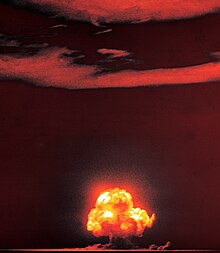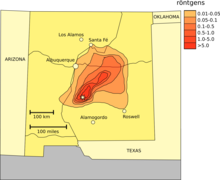Trinity test
|
Nuclear test Trinity test
|
|
|---|---|
![Trinity explosion (so-called fire bubble 0.025 seconds after ignition. [1])](https://upload.wikimedia.org/wikipedia/commons/thumb/7/78/Trinity_Test_Fireball_16ms.jpg/250px-Trinity_Test_Fireball_16ms.jpg) Trinity explosion (so-called fire bubble 0.025 seconds after ignition.) |
|
| information | |
| nation |
|
| Test location | White Sands Proving Grounds |
| date | July 16, 1945, 5:29:45 am |
| Test type | Above-ground test |
| Weapon type | Fission (implosion) |
| Explosive power | 21 kT |
| navigation | |
| Previous test | - |
| Next test | Operation Crossroads |
| ||
Some locations of the Manhattan Project |
The Trinity-Test [ ʼtriniti test ] ( English for Trinity , Trinity ) was the first ever nuclear weapon explosion . The test was carried out on July 16, 1945 at 5:29:45 a.m. local time by the United States as part of the Manhattan Project , the United States' nuclear weapons development project. Trinity was the U.S. military's code name for this attempt. The code name of the weapon was The Gadget ("the device").
Test procedure
The test weapon, a plutonium - implosion bomb was on a 30-meter-high steel tower in the White Sands Proving Grounds in the State of New Mexico ignited. The original time was set at 4 a.m., but due to bad weather the test was delayed until 5:29:45 a.m. local time. The explosion, which released 88 TJ of energy, that is, had an explosive force of 21 kilotons of TNT equivalent , left a three meter deep and 330 meter wide crater ( 33 ° 40 ′ 38.3 ″ N , 106 ° 28 ′ 31.5 ″ W ) in the desert. The pressure wave could be felt 160 kilometers away and the mushroom cloud typical of an atomic bomb reached a height of 12 kilometers. The sand in the explosion environment melted into greenish glass ( trinitite ) because of the great heat .
To hide the test, the military reported that it had been an ammunition dump explosion and did not reveal the truth until August 6, the day the Hiroshima bomb was dropped .
Before the test, a load of 100 tons of Composition B was detonated on May 7th to calibrate the measuring devices.
260 people were present at the test who were nine kilometers away from the explosion site. In the next tests ( Operation Crossroads ) in 1946 there were 40,000 people.
The test site (English Trinity site ) was declared a National Historic Landmark (official historic site of national importance) in December 1965 . The site was added to the National Register of Historic Places as a Historic District in October 1966 . Since the Trinity site is still located in the middle of the White Sands military area, it is usually cordoned off, but open to the public on the first Saturday in April and October. A black obelisk marks the point at which the nuclear weapon was ignited, where there is still a small amount of residual radiation. In addition, you can find green glass, called trinitite , made of sand that has rained down, evaporated or of rock from the surface of the test site.
One of the scientists involved later commented on the Trinity test:
"After that I attended many tests, including those of the first hydrogen bombs , but nothing can be compared to this first test explosion, the nuclear big bang."
Radiation exposure
The explosion on a tower favored fallout . Terrain and wind caused radioactive “hot spots”. Farmers observed flour-like fallout for four to five days. Residents within a radius of around 20 kilometers used rainwater as drinking water. There were no warnings to residents or information about protection options or possible evacuations. With unsuitable instruments, exposure rates of up to 1.4 µC / kg / s were recorded, whereby the extent of the α-emitter contamination from around 4.8 kilograms of unbroken plutonium could hardly be determined. To date, the measurement data from this field trial have not been rigorously evaluated, and the dose levels of the affected public due to air, water and food contamination have not been determined.
Next episodes
In terms of weapons technology, the test was rated as successful and led to the weapon being released to the political and military leadership. Two different bombing techniques were used: the atomic bombs were dropped on Hiroshima and Nagasaki on
- August 6th over Hiroshima ( Little Boy ), with a simply constructed uranium bomb, and on
- August 9 via Nagasaki ( Fat Man , also of the implosion type like Trinity; strength in the range from 20 to 22 kt)
The Little Boy bomb was based on the simple but reliable " cannon principle ". A failure of the construction was considered very unlikely, so that a test was not carried out.
Further tests followed from 1946 to examine the use in the various branches of arms. See the list of nuclear weapons tests .
Naming
To be on the safe side, the test site was given an alias. Robert Oppenheimer chose the expression "Trinity" (German " Dreifaltigkeit ") for this. In 1962, General Groves asked Oppenheimer in writing whether the name came from the fact that "Trinity" was a common name for rivers and mountains in the western United States. Oppenheimer replied that when he gave the name, he was thinking of a poem by John Donne . There it says: "Smash my heart, Triune God". He has no further explanation. The “Trinity” bomb itself gave its name to the alpha emitter Trinitit , an artificial glass created from molten sand during the explosion.
See also
- "Aldebaran": First French nuclear test in the Pacific, Mururoa Atoll , July 2, 1966
- " Able (Operation Crossroads) ": First US test after World War II in the Pacific, Bikini Atoll , June 30, 1946
Web links
- cddc.vt.edu: Trinity Atomic Web Site (archive version )
-
nuclearweaponarchive.org: Trinity test
- Film of the test (without sound, MPEG, 240 kB; MPG )
- Film of the test (with sound, QuickTime, 960 kB)
Individual evidence
- ↑ Claus Biegert (ed.): The Monday that changed the world , Rowohlt 1996, ISBN 3-499-13939-1 , p. 23 ff.
- ↑ BBC , July 15, 2005, Kathryn Westcott, news.bbc.co.uk: The day the world lit up
- ↑ Listing of National Historic Landmarks by State: New Mexico. National Park Service , accessed August 17, 2019.
- ^ Trinity Site on the National Register Information System. National Park Service , accessed November 14, 2019.
- ↑ TE Widner, SM Flack: Characterization of the world's first nuclear explosion, the Trinity test, as a source of public radiation exposure. Health Phys 98 (2010), pp. 480-497; doi : 10.1097 / HP.0b013e3181c18168 ; PMID 20147790 ; PDF .
- ^ "Batter my heart, three-person'd God" ; Accessed January 11, 2007.
- ↑ John Donne HOLY SONNETS XIV. “ Batter my heart, three-person'd God; for you As yet but knock; breathe, shine, and seek to mend; That I may rise, and stand, o'throw me, and bend your force, to break, blow, burn, and make me new. I, like an usurp'd town, to another due, Labor to admit you, but O, to no end. Reason, your viceroy in me, me should defend, But is captived, and proves weak or untrue. Yet dearly I love you, and would be loved fain, But am betroth'd unto your enemy; Divorce me, untie, or break that knot again, Take me to you, imprison me, for I, Except you enthrall me, never shall be free, Nor ever chaste, except you ravish me. "; Source: Donne, John. Poems of John Donne. vol IEK Chambers, ed. London: Lawrence & Bullen, 1896. 165; Accessed August 6, 2008, 9:30 p.m.
- ↑ "I did suggest it, but not on that ground ... Why I chose the name is not clear, but I know what thoughts were in my mind. There is a poem of John Donne, written just before his death, which I know and love. From it a quotation: 'As West and East / In all flatt Maps — and I am one — are on, / So death doth touch the Resurrection.' ”(“ Hymn to God My God, in My Sicknesses ”). Oppenheimer continued, “That still does not make a Trinity, but in another, better known devotional poem Donne opens, 'Batter my heart, three person'd God; -.' Beyond this, I have no clues whatever. "( Holy Sonnets XIV). Source: Richard Rhodes, The Making of the Atomic Bomb; New York: Simon & Schuster, 1986; Pp. 571-572.
- ^ THE TRINITY TEST Trinity Test Site (July 16, 1945) ( Memento from September 29, 2006 in the Internet Archive ) "Robert Oppenheimer chose to name this the 'Trinity' test, a name inspired by the poems of John Donne."; Accessed August 6, 2008, 9:00 p.m.
- ↑ Countdown to the Eve of Destruction , by ANTHONY TOMMASINI; New York Times, October 3, 2005 “(...) the first bomb was tested at the site that Oppenheimer, inspired by a John Donne poem, called Trinity. (...) "; Accessed August 6, 2008, 9:00 p.m.
- ↑ Los Alamos National Laboratory - Trinity: Completion of the Wartime Mission "(...) Los Alamos Director J. Robert Oppenheimer named the site 'Trinity' after a poem by John Donne that he had been reading. (...) "; Accessed August 6, 2008, 9:20 pm.







